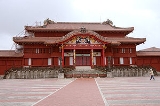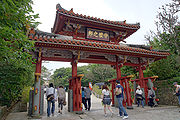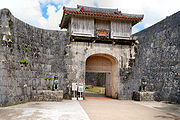
Shuri Castle
Encyclopedia

Gusuku
, or just , is the term used for the distinctive Okinawan form of castles or fortresses. In standard Japanese, the same kanji is pronounced "shiro", but the word is probably cognate with a different Japanese word, "soko" , which means "fortress"...
(Ryūkyūan castle) in Shuri, Okinawa
Okinawa Prefecture
is one of Japan's southern prefectures. It consists of hundreds of the Ryukyu Islands in a chain over long, which extends southwest from Kyūshū to Taiwan. Okinawa's capital, Naha, is located in the southern part of Okinawa Island...
. It was the palace of the Ryūkyū Kingdom
Ryukyu Kingdom
The Ryūkyū Kingdom was an independent kingdom which ruled most of the Ryukyu Islands from the 15th century to the 19th century. The Kings of Ryūkyū unified Okinawa Island and extended the kingdom to the Amami Islands in modern-day Kagoshima Prefecture, and the Sakishima Islands near Taiwan...
. In 1945, during the Battle of Okinawa
Battle of Okinawa
The Battle of Okinawa, codenamed Operation Iceberg, was fought on the Ryukyu Islands of Okinawa and was the largest amphibious assault in the Pacific War of World War II. The 82-day-long battle lasted from early April until mid-June 1945...
, it was almost completely destroyed. In 1992, it was reconstructed on the original site based on photographs, historical records, and memory.
History
The date of construction is uncertain, but it was clearly in use as a castle during the Sanzan periodSanzan period
The is a period of history of the Ryūkyū Kingdom that lasted from 1322 until 1429.The early 13th century saw a growth in the construction of Gusuku by a number of powerful kings leading to the emergence of three kingdoms in the 14th century: , and...
. It is thought that it was probably built during the Gusuku period, like the other castles of Okinawa. When King Shō Hashi
Sho Hashi
Shō Hashi was the first king of the Ryūkyū Kingdom , uniting the three kingdoms of Chūzan, Hokuzan, and Nanzan by conquest...
unified the three sections of Okinawa and established the Ryūkyū Kingdom
Ryukyu Kingdom
The Ryūkyū Kingdom was an independent kingdom which ruled most of the Ryukyu Islands from the 15th century to the 19th century. The Kings of Ryūkyū unified Okinawa Island and extended the kingdom to the Amami Islands in modern-day Kagoshima Prefecture, and the Sakishima Islands near Taiwan...
, he used Shuri Castle as a residence. At the same time, Shuri flourished as the capital, and continued to do so during the second Sho dynasty.
For 450 years from the beginning of the 15th century, it was the royal court and administrative center of the Ryūkyūan Kingdom. It was the focal point of foreign trade, as well as the political, economical and cultural heart of the Ryūkyūs.
According to records, Shuri Castle burned several times and was reconstructed each time. Before the war, it was designated a national treasure
National treasures of Japan
National Treasures are the most precious of Japan's Tangible Cultural Properties, as determined and designated by the Agency for Cultural Affairs...
. However, during the war, the Japanese military set up its headquarters in the castle underground, and, beginning on May 25, 1945, the American battleship shelled it for three days. On May 27 it burned. After the battle, a Confederate battle flag (which personally belonged to the company commander) was hoisted above the castle by the "Rebel Company" A of the 5th Marine Regiment. It was visible for over two miles and stayed above the castle for three days until it was removed by General Simon B. Buckner, Jr. (son of Confederate General Simon Bolivar Buckner, Sr.
Simon Bolivar Buckner, Sr.
Simon Bolivar Buckner fought in the United States Army in the Mexican–American War and in the Confederate States Army during the American Civil War. He later served as the 30th Governor of Kentucky....
), who stated that Americans from all parts of America helped to win the battle.
After the war, the University of the Ryūkyūs moved to the castle site, where it remained until 1975. In 1958, the Shureimon
Shureimon
This article is about the gate in the Shuri neighborhood in Japan. For the Digimon see Hawkmon.Shureimon is a gate in the Shuri neighborhood of Naha, the capital of Okinawa Prefecture, Japan. It is the second of Shuri Castle's main gates...
gate was reconstructed, and, in 1992, the main building of the castle was reconstructed. At present, the entire area around the castle has been established as Shuri Castle Park. In 2000, along with other gusuku and related sites, it was designated as a UNESCO World Heritage Site
World Heritage Site
A UNESCO World Heritage Site is a place that is listed by the UNESCO as of special cultural or physical significance...
.
Sites of interest
Because of its central role in Ryūkyūan political and religious life, Shuri Castle is surrounded by various sites of historical interest. Featured in their own articles are ShureimonShureimon
This article is about the gate in the Shuri neighborhood in Japan. For the Digimon see Hawkmon.Shureimon is a gate in the Shuri neighborhood of Naha, the capital of Okinawa Prefecture, Japan. It is the second of Shuri Castle's main gates...
, the main gate to the castle, and Tamaudun
Tamaudun
is a mausoleum in Shuri, Okinawa, built for Ryūkyūan royalty in 1501 by King Shō Shin, the third king of the second Shō dynasty a short distance from Shuri Castle....
, the royal tombs located adjacent to Shuri Castle.
Stone Gate of Sonohyan-utaki

Shureimon
This article is about the gate in the Shuri neighborhood in Japan. For the Digimon see Hawkmon.Shureimon is a gate in the Shuri neighborhood of Naha, the capital of Okinawa Prefecture, Japan. It is the second of Shuri Castle's main gates...
gate was erected in 1519 by King
Monarch
A monarch is the person who heads a monarchy. This is a form of government in which a state or polity is ruled or controlled by an individual who typically inherits the throne by birth and occasionally rules for life or until abdication...
Shō Shin
Sho Shin
' was a king of the Ryūkyū Kingdom, the third of the line of the Second Shō Dynasty. Shō Shin's long reign has been described as "the Great Days of Chūzan", a period of great peace and relative prosperity. He was the son of Shō En, the founder of the dynasty, by Yosoidon, Shō En's second wife,...
, the third king of the second Shō dynasty. Here at the Sonohyan-utaki
Utaki
うたき is an album by Japanese singer/pianist Misako Odani, released March 25, 1999 on the Universal label. It was co-produced by Misako and Hirokazu Sakurai from Hip Land Music...
, the king offered prayer
Prayer
Prayer is a form of religious practice that seeks to activate a volitional rapport to a deity through deliberate practice. Prayer may be either individual or communal and take place in public or in private. It may involve the use of words or song. When language is used, prayer may take the form of...
s for order throughout the kingdom and safety at the outset of all his travels. The stone gate reflects the kingdom's advanced limestone
Limestone
Limestone is a sedimentary rock composed largely of the minerals calcite and aragonite, which are different crystal forms of calcium carbonate . Many limestones are composed from skeletal fragments of marine organisms such as coral or foraminifera....
masonry skills. It is designated an important national cultural property, and is itself also registered as a distinct element of the collective UNESCO World Heritage site designated as Gusuku Sites and Related Properties of the Kingdom of Ryukyu
Gusuku Sites and Related Properties of the Kingdom of Ryukyu
The Gusuku Sites and Related Properties of the Kingdom of Ryukyu is an UNESCO World Heritage Site which consists of nine sites all located in Okinawa Prefecture, Japan. The heritage sites include two groves or utaki, the mausoleum Tamaudun, one garden, and five gusuku castles sites, most of which...
, alongside Shuri Castle itself.
Shikina-en
Built in 1799, the royal gardens and villaVilla
A villa was originally an ancient Roman upper-class country house. Since its origins in the Roman villa, the idea and function of a villa have evolved considerably. After the fall of the Roman Republic, villas became small farming compounds, which were increasingly fortified in Late Antiquity,...
were not only where the royals relaxed but was also used to host the investiture envoys who came from the Great Empire, China. The garden's circle layout resembles plans used in modern Japanese garden
Japanese garden
, that is, gardens in traditional Japanese style, can be found at private homes, in neighborhood or city parks, and at historical landmarks such as Buddhist temples, Shinto shrines and old castles....
s, but the villa itself with its red tile is uniquely Ryūkyūan, and pond and bridge to the miniature island is in the Chinese style. This is a rare, historically valuable example of Ryūkyūan landscape gardening
Landscape architecture
Landscape architecture is the design of outdoor and public spaces to achieve environmental, socio-behavioral, or aesthetic outcomes. It involves the systematic investigation of existing social, ecological, and geological conditions and processes in the landscape, and the design of interventions...
, and Shikina-en is also registered as a distinct element of the collective UNESCO World Heritage site designated as "Gusuku Sites and Related Properties of the Kingdom of Ryukyu", alongside Shuri Castle itself.
Kankaimon

Battle of Okinawa
The Battle of Okinawa, codenamed Operation Iceberg, was fought on the Ryukyu Islands of Okinawa and was the largest amphibious assault in the Pacific War of World War II. The 82-day-long battle lasted from early April until mid-June 1945...
in 1945 and restored in 1974. Kankaimon is the first front gate to Shuri Castle, kankai (歓会), which means "welcome". The gate was named to express welcome to the investiture envoys who visited Shuri Castle as representatives of the Chinese Emperor.
"Bridge of Nations" Bell
The was cast in 1458, during the reign of King Shō TaikyūShō Taikyū
' was a king of the Ryūkyū Kingdom, the fifth of the line of the first Shō Dynasty. His reign saw the construction of many Buddhist temples, and the casting of the .- Life and reign :...
, and hung at the Seiden (main hall) of the castle. The 721 kg
Kilogram
The kilogram or kilogramme , also known as the kilo, is the base unit of mass in the International System of Units and is defined as being equal to the mass of the International Prototype Kilogram , which is almost exactly equal to the mass of one liter of water...
bell is today in the collection of the Okinawa Prefectural Museum
Okinawa Prefectural Museum
The ' is a museum complex in the Omoro-machi area of Naha, the capital city of Okinawa Prefecture in Japan. It opened in November 2007, and includes art, history, and natural history museums focusing specifically on Okinawan topics....
; a full-size replica hangs on the castle site.
The inscription on the bell describes Ryūkyū's prominence in maritime trade in the South Seas
Nanyang (geographical region)
Nanyang is the Chinese name for the geographical region south of China, particularly Southeast Asia. Literally meaning "Southern Ocean", it came into common usage in self-reference to the large ethnic Chinese migrant population in Southeast Asia, to be more precise, in Singapore, the Philippines,...
and prosperous trade relations with China, Korea, Japan, and the various states of Southeast Asia; the bell's name derives from this.
See also
- List of Special Places of Scenic Beauty, Special Historic Sites and Special Natural Monuments
- Tourism in JapanTourism in JapanTourism in Japan attracted 8.3 million foreign visitors in 2008, slightly more than Singapore and Ireland. Japan has 16 World Heritage Sites, including Himeji Castle and Historic Monuments of Ancient Kyoto . Kyoto receives over 30 million tourists annually...

